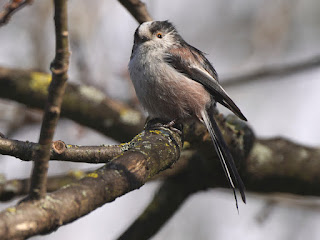A Dunnock sang from a bramble on Buck Hill.
The Long-Tailed Tits at the bridge were busy around their nest in the bushes.
A Great Tit looked for insects in the nearby dead tree.
A Jackdaw at the leaf yard was expecting a peanut. It can be quite hard to get them fed in the middle of a mob of Carrion Crows, but they are intelligent enough to work out evasive strategies.
There's no problem with Jays as they will fly to your hand and grab the peanut as they pass.
A Great Crested Grebe's reflexes are fast enough to catch midges in midair.
Now I know what's at the end of the rainbow. It's a Coot.
The bereaved Moorhen has gone back to the Dell. With luck it should recover and go up to the lake to find a new mate. There are several young Moorhens hatched last year.
There was a new family of Egyptian Geese at Peter Pan ...
... not a safe place with hungry Lesser Black-Backed Gulls ...
... and a Grey Heron staring down at them from the posts.
A view of the heron family on the island from the other side of the lake, with a parent keeping well out of the way of the demanding youngsters.
It was less windy than yesterday, but there was enough of a breeze to encourage two Mute Swans to fly.
A pair of Mandarins browsed along the water's edge. We aren't seeing these beautiful ducks as often as we used to, since the teeming Herring Gulls make it impossible for them to breed here.
There were plenty of bees on the borders in the Rose Garden. The first two shots are of a Garden Bumblebee and a Buff-Tailed Bumblebee, and the next two of Southern Cuckoo Bumblebees. But the long-legged insect in the last two shots has me baffled. It seems to be some kind of hoverfly but I can't find anything that looks like it.
Here is a closer look at it. Update: L. Fairfax has identified it as a Bee Fly, but not sure which species. Later: Conehead 54 has identified it as a Dark-Edged Bee Fly, Bombylius major.
Tom was at Rainham Marshes, where he got excellent pictures of a female Brambling ...
... and a Water Rail.















That hoverfly is a bee fly. Not sure which one.
ReplyDeleteThanks for the identification.
DeleteIt took me a lot of digging to find out that bombus vestalis is called in Spanish "abejorro cuco", just like Eng. "cuckoo bumblebee". I had never seen the name before.
ReplyDeleteAt the end of the rainbow or behind a screen in a throne room's corner, there will always be a Coot.
Every king and every president should have a Coot on his shoulder to peck him when he gets ideas above his station.
DeleteThe beefly is the most common one- the Dark-edged Beefly, Bombylius major.
ReplyDeleteYour bee video seems to feature a Garden Bumblebee, Bombus hortorum, at the very start-note the extra yellowish band & the long face. This is immediately followed by the Buff-tail.
Lovely shots of the Jay & those menacing Lesser Black-backs. The Coot rainbow is a nice touch.
Glorious insect weather to come this week!
Many thanks for the identifications. I've amended the text.
DeleteJust hear from Bill Haines. His Coot, White FJX, which went to St Petersburg is now back on the Round Pond.
Amazing how much these Coots travel. Interesting information, Ralph.
ReplyDelete